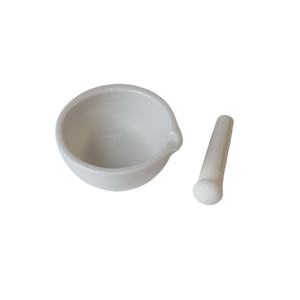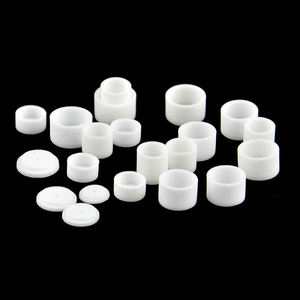1. The Product Foundation and Crystallographic Identification of Alumina Ceramics
1.1 Atomic Style and Stage Security
(Alumina Ceramics)
Alumina porcelains, primarily composed of light weight aluminum oxide (Al ā O FOUR), stand for one of one of the most extensively used classes of sophisticated ceramics as a result of their phenomenal balance of mechanical strength, thermal resilience, and chemical inertness.
At the atomic degree, the performance of alumina is rooted in its crystalline framework, with the thermodynamically secure alpha phase (Ī±-Al ā O FIVE) being the leading form made use of in design applications.
This stage embraces a rhombohedral crystal system within the hexagonal close-packed (HCP) latticework, where oxygen anions develop a dense plan and light weight aluminum cations inhabit two-thirds of the octahedral interstitial websites.
The resulting structure is very secure, contributing to alumina’s high melting factor of around 2072 Ā° C and its resistance to decomposition under severe thermal and chemical conditions.
While transitional alumina stages such as gamma (Ī³), delta (Ī“), and theta (Īø) exist at reduced temperatures and display greater surface areas, they are metastable and irreversibly transform into the alpha phase upon home heating over 1100 Ā° C, making Ī±-Al ā O ā the unique stage for high-performance structural and functional components.
1.2 Compositional Grading and Microstructural Engineering
The homes of alumina porcelains are not repaired however can be tailored through regulated variations in pureness, grain dimension, and the addition of sintering aids.
High-purity alumina (ā„ 99.5% Al ā O FIVE) is utilized in applications requiring optimum mechanical stamina, electric insulation, and resistance to ion diffusion, such as in semiconductor processing and high-voltage insulators.
Lower-purity grades (ranging from 85% to 99% Al Two O FOUR) often incorporate secondary phases like mullite (3Al ā O TWO Ā· 2SiO ā) or glazed silicates, which boost sinterability and thermal shock resistance at the expense of solidity and dielectric performance.
A crucial factor in efficiency optimization is grain dimension control; fine-grained microstructures, achieved through the enhancement of magnesium oxide (MgO) as a grain development inhibitor, substantially enhance fracture sturdiness and flexural toughness by limiting crack proliferation.
Porosity, even at reduced degrees, has a harmful effect on mechanical stability, and totally thick alumina ceramics are commonly produced via pressure-assisted sintering methods such as warm pushing or hot isostatic pressing (HIP).
The interaction between structure, microstructure, and processing defines the useful envelope within which alumina ceramics run, enabling their use across a huge range of commercial and technical domain names.
( Alumina Ceramics)
2. Mechanical and Thermal Efficiency in Demanding Environments
2.1 Toughness, Firmness, and Use Resistance
Alumina ceramics display an unique combination of high hardness and modest fracture durability, making them perfect for applications involving unpleasant wear, disintegration, and influence.
With a Vickers hardness usually varying from 15 to 20 Grade point average, alumina ranks among the hardest engineering materials, exceeded only by ruby, cubic boron nitride, and particular carbides.
This severe hardness equates into remarkable resistance to scratching, grinding, and particle impingement, which is exploited in parts such as sandblasting nozzles, reducing tools, pump seals, and wear-resistant liners.
Flexural stamina values for dense alumina variety from 300 to 500 MPa, depending upon pureness and microstructure, while compressive stamina can surpass 2 Grade point average, allowing alumina components to hold up against high mechanical tons without deformation.
Regardless of its brittleness– an usual characteristic among porcelains– alumina’s efficiency can be enhanced through geometric layout, stress-relief functions, and composite support approaches, such as the incorporation of zirconia particles to cause transformation toughening.
2.2 Thermal Behavior and Dimensional Security
The thermal buildings of alumina ceramics are main to their usage in high-temperature and thermally cycled settings.
With a thermal conductivity of 20– 30 W/m Ā· K– higher than most polymers and similar to some steels– alumina effectively dissipates heat, making it appropriate for warm sinks, shielding substratums, and heater elements.
Its reduced coefficient of thermal growth (~ 8 Ć 10 ā»ā¶/ K) ensures marginal dimensional change during cooling and heating, lowering the threat of thermal shock fracturing.
This stability is particularly useful in applications such as thermocouple security tubes, spark plug insulators, and semiconductor wafer dealing with systems, where accurate dimensional control is critical.
Alumina preserves its mechanical integrity up to temperatures of 1600– 1700 Ā° C in air, beyond which creep and grain border gliding might initiate, relying on purity and microstructure.
In vacuum or inert environments, its performance expands also better, making it a favored product for space-based instrumentation and high-energy physics experiments.
3. Electrical and Dielectric Characteristics for Advanced Technologies
3.1 Insulation and High-Voltage Applications
One of one of the most considerable useful characteristics of alumina porcelains is their superior electric insulation capability.
With a volume resistivity going beyond 10 Ā¹ā“ Ī© Ā· cm at area temperature level and a dielectric toughness of 10– 15 kV/mm, alumina acts as a trustworthy insulator in high-voltage systems, including power transmission equipment, switchgear, and digital product packaging.
Its dielectric constant (Īµįµ£ ā 9– 10 at 1 MHz) is reasonably stable across a broad frequency range, making it appropriate for use in capacitors, RF elements, and microwave substrates.
Low dielectric loss (tan Ī“ < 0.0005) ensures very little energy dissipation in alternating existing (AIR CONDITIONER) applications, enhancing system effectiveness and reducing heat generation.
In published circuit card (PCBs) and hybrid microelectronics, alumina substrates provide mechanical support and electric isolation for conductive traces, allowing high-density circuit assimilation in rough environments.
3.2 Performance in Extreme and Sensitive Atmospheres
Alumina ceramics are distinctively matched for use in vacuum, cryogenic, and radiation-intensive atmospheres because of their reduced outgassing prices and resistance to ionizing radiation.
In particle accelerators and blend activators, alumina insulators are used to isolate high-voltage electrodes and diagnostic sensing units without presenting impurities or degrading under prolonged radiation direct exposure.
Their non-magnetic nature likewise makes them optimal for applications including strong magnetic fields, such as magnetic vibration imaging (MRI) systems and superconducting magnets.
In addition, alumina’s biocompatibility and chemical inertness have led to its fostering in medical devices, consisting of oral implants and orthopedic elements, where long-lasting security and non-reactivity are extremely important.
4. Industrial, Technological, and Emerging Applications
4.1 Role in Industrial Equipment and Chemical Processing
Alumina porcelains are extensively utilized in industrial devices where resistance to use, corrosion, and high temperatures is vital.
Parts such as pump seals, shutoff seats, nozzles, and grinding media are typically made from alumina because of its ability to stand up to rough slurries, hostile chemicals, and elevated temperature levels.
In chemical handling plants, alumina linings protect reactors and pipelines from acid and antacid attack, prolonging tools life and minimizing upkeep expenses.
Its inertness likewise makes it ideal for use in semiconductor construction, where contamination control is important; alumina chambers and wafer watercrafts are exposed to plasma etching and high-purity gas atmospheres without seeping impurities.
4.2 Assimilation right into Advanced Manufacturing and Future Technologies
Past standard applications, alumina ceramics are playing a significantly important role in emerging innovations.
In additive production, alumina powders are used in binder jetting and stereolithography (SHANTY TOWN) processes to produce facility, high-temperature-resistant parts for aerospace and power systems.
Nanostructured alumina movies are being checked out for catalytic assistances, sensing units, and anti-reflective finishings because of their high surface and tunable surface area chemistry.
In addition, alumina-based compounds, such as Al Two O TWO-ZrO ā or Al ā O SIX-SiC, are being developed to conquer the inherent brittleness of monolithic alumina, offering boosted durability and thermal shock resistance for next-generation architectural materials.
As markets remain to press the borders of performance and dependability, alumina porcelains remain at the center of product technology, connecting the space between structural effectiveness and practical adaptability.
In summary, alumina porcelains are not merely a course of refractory products however a foundation of contemporary design, making it possible for technical progression across energy, electronic devices, medical care, and commercial automation.
Their one-of-a-kind mix of residential or commercial properties– rooted in atomic framework and fine-tuned with innovative handling– guarantees their continued relevance in both established and emerging applications.
As material science evolves, alumina will undoubtedly remain an essential enabler of high-performance systems running beside physical and ecological extremes.
5. Vendor
Alumina Technology Co., Ltd focus on the research and development, production and sales of aluminum oxide powder, aluminum oxide products, aluminum oxide crucible, etc., serving the electronics, ceramics, chemical and other industries. Since its establishment in 2005, the company has been committed to providing customers with the best products and services. If you are looking for high quality alumina insulator, please feel free to contact us. (nanotrun@yahoo.com)
Tags: Alumina Ceramics, alumina, aluminum oxide
All articles and pictures are from the Internet. If there are any copyright issues, please contact us in time to delete.
Inquiry us


http://www.advancedceramics.co.uk
I recently purchased alumina ceramic plates from TRUNNANO, and Iām extremely impressed with their quality. The plates exhibit exceptional hardness, wear resistance, and thermal stability, making them perfect for high-performance applications. The precision in dimensions and smooth surface finish are outstanding. TRUNNANOās customer service was also top-notchāresponsive and professional. Whether for industrial or research purposes, these ceramic plates deliver unmatched reliability. Highly recommended for anyone seeking durable, high-purity alumina solutions. TRUNNANO continues to exceed expectations with their superior ceramic products!
http://www.advancedceramics.co.uk
I recently purchased alumina ceramic plates from TRUNNANO, and Iām extremely impressed with their quality. The plates exhibit exceptional hardness, wear resistance, and thermal stability, making them perfect for high-performance applications. The precision in dimensions and smooth surface finish are outstanding. TRUNNANOās customer service was also top-notchāresponsive and professional. Whether for industrial or research purposes, these ceramic plates deliver unmatched reliability. Highly recommended for anyone seeking durable, high-purity alumina solutions. TRUNNANO continues to exceed expectations with their superior ceramic products!